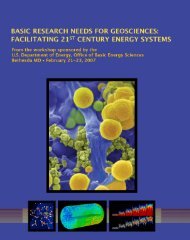Cyber Physical Systems â Situation Analysis - Energetics Meetings ...
Cyber Physical Systems â Situation Analysis - Energetics Meetings ...
Cyber Physical Systems â Situation Analysis - Energetics Meetings ...
- No tags were found...
You also want an ePaper? Increase the reach of your titles
YUMPU automatically turns print PDFs into web optimized ePapers that Google loves.
<strong>Cyber</strong> <strong>Physical</strong> <strong>Systems</strong> – <strong>Situation</strong> <strong>Analysis</strong>DRAFT – March 9, 2012to determine how they will react to instances such as equipment failures. 204 Other benefits of a test bedinclude being able to speed up and standardize evaluation and validation, provide a basis of comparison,and reduce need for duplicative test beds. Buildings will not become more intelligent until there are bestpractice guidelines for intelligent system design, operation, and maintenance, leading to the developmentof algorithms that respond to exterior (e.g. weather conditions) and interior sources (e.g. occupancysensors). 205 Test beds could enable more energy efficient building operation through the development ofinformation models and software tools that improve the design and commissioning process and increaseduse of embedded intelligence that can detect and respond to problems and optimize the control andperformance of building systems. 206Sensors for Monitoring Bridges and Other StructuresThe development of more robust and advanced smart sensors could help provide valuable informationabout the health of various structures, including bridges, tunnels, buildings, and water distributionsystems. While ―smart bridge‖ technology is emerging, current systems that use discrete sensors areinadequate to completely monitor the large, complicated systems that suffer local abnormalities. 207Sensors can provide valuable insight on the structural health and condition of bridges or buildings, butfull scale, effective networks of sensors on bridges (or other types of civil infrastructure) will not becomecommon until challenges are overcome. The continual improvement of wireless sensors is essentialbecause they will reduce the need of also installing costly and bulky wires. It must be determined whatthe sensors will measure about the bridge (e.g., strain, cracking, corrosion, scour, environmentalconditions). Based upon the requirements, sensors must be developed to address certain environments orconditions. Examples include sensor technology for underwater or extreme temperature environments,sensors that can self-monitor their health or sensors that can measure the aging effects of materials.Sensors with the ability to accurately detect and predict the rate of something like corrosion would beespecially useful for areas of the bridge that cannot be monitored visually. 208One of the main difficulties in implementing a sensor network for structural monitoring is that damage isnormally localized, meaning that the sensors must be densely allocated over the whole structure and beable to detect very small changes in a large system in a timely manner in order to be most effective. Thereare challenges in reconciling the sensor placement, especially when considering the high cost ofdeploying large sensor networks. In a system of sensors, it is likely that one or more sensors will fail, andthe remaining sensors must be able to compensate for that failure. The design lifetime of the sensors andsystem as a whole present a challenge, because most structures such as bridges are designed for lifetimesof 50 to 100 years or possibly longer. How long will the sensors last and then how and when will they bereplaced to ensure continuity? Hardware and software upgrades should be easily implemented over thelifetime of the structure, and these costs of replacement and maintenance should be considered. 209There are numerous other challenges and concerns that must be eliminated to achieve effective, reliable,and economical structural health monitoring using sensor systems. There are many different types ofsensors that measure different properties at different rates, some of which were not designed forapplications such as bridge monitoring but may be of use (e.g., traffic or security cameras). Also, just204 NIST. ―Embedded Intelligence in Buildings.‖205 NIST. ―Measurement Science Roadmap Report.‖206 NIST. ―Embedded Intelligence in Buildings.‖207 French, Catherine et al. ―Report on the NSF Bridge Condition Monitoring and Prognostication Workshop.‖ Nov 2008.208 French, C. et al. ―Report on the NSF Bridge Workshop.‖209 French, C. et al. ―Report on the NSF Bridge Workshop.‖36
















